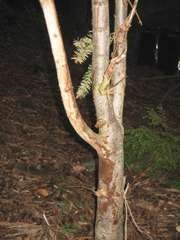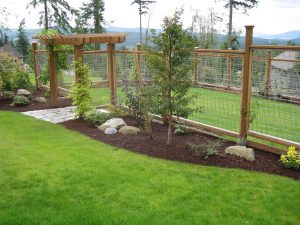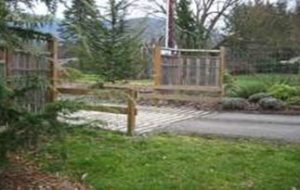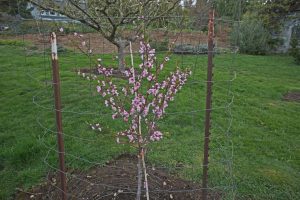
Antler damage
Download a pdf on Living with Deer
Deer are a fact of life for many of us. They are charming to look at, but they can wreak havoc in the garden. Not only do they browse the plants, but the bucks will quickly destroy a plant when rubbing their antlers during the late summer and autumn rut. How can you garden in deer country?
Build a fence
The most effective way to garden in deer country is to fence the garden. Ask yourself these questions before fencing your garden:
- Do you need to fence the entire property, or can you just fence a garden area?
- Can you fence young plants temporarily, until they are big enough to withstand some deer damage?
- Are there constraints to fences, such as community regulations against certain types of fencing?
- Is building a fence worth the expense and time?

Deer fence
If you decide to build a fence, make sure it is constructed properly. An effective deer fence needs to be at least 8′ high if using wire. A board fence that deer cannot see through needs to be at least 5 ½ ‘-6′ high. Also effective is a 4′ high, double fence, with 3′-4′ in between the fences. A deer will not jump this because there is not enough room between the fences for a safe landing. Electric fences of 8 wires spaced evenly up to 7’ also works, but takes more maintenance than a non-electric fence. Gates should be strongly constructed. For a drive through opening, two widths of cattle guard keep deer out as it is too wide to jump.

Cattle guard driveway
Mini-Fences

Individual tree fence
Fencing individual plants until they are large enough to tolerate some deer pressure is a common practice. Use 3-4 stakes around the tree to support the fence. It should be at least 5′ high. Black, polypropylene deer mesh works well for this. Make sure you can easily open the fence to do any plant maintenance required. Bird netting can also be draped over or around plants as a temporary barrier.
Repellents
Repellents need to be used before the deer have tasted a plant. They also need to be reapplied frequently, and work best if deer pressure is light. Deer can also become accustomed to the same repellent and begin to ignore it, so you may need to change formulas occasionally.
Scare Tactics
Deer can be scared away using scarecrows, bright lights, radios, etc. Unfortunately, they can become accustomed to any tactic used over a period of time. Moving the scare objects frequently can work. One recent innovation is a sprinkler activated by a motion sensor, which also needs to be moved frequently. Dogs are effective at keeping deer out of your yard, if they are in the yard and are active. Using an electric “invisible” fence to keep the dog in the yard is the most effective method.
Planting “Deer Resistant” Plants
In areas of severe deer pressure, the deer will eat anything. No plant is resistant to the antler rubbing damage. Some of the list below are USUALLY left alone.
Homemade Deer Repellent
- Mix the following in a 1 gallon tank sprayer:
- 2 beaten and strained eggs (straining keeps the eggs from clogging the sprayer)
- 1 cup milk, yogurt, buttermilk, or sour milk
- 2 tsp. Tabasco sauce or cayenne pepper
- 20 drops essential oil of clove, cinnamon, or eucalyptus
- 1 tsp. cooking oil or dormant oil
- 1 tsp. liquid dish soap
Top the tank with water. Shake frequently while spraying. Apply to dry foliage. Will last 2-4 weeks in dry weather; reapply after rain.
Internet Resources:
WSU Hortsense and Washington State Department of Fish and Wildlife
